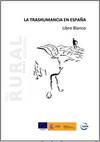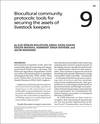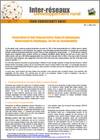Providing empirical evidence from Kenya, Tanzania and Mozambique, and from different production systems, this book illustrates that livestock is an important asset to women and their participation in livestock and livestock product markets. It explores the issues of intra-household income management and economic benefits of livestock markets to women, focusing on how the types of markets and products, and women’s participation in markets, influence their access to livestock income.
The book further analyzes the role of livestock ownership, especially by women, in influencing household food security by increasing household dietary diversity and food adequacy. Additional issues addressed include access to resources, information, and financial services to enable women to more effectively participate in livestock production and marketing. Factors that influence this access are also examined.
Practical strategies for increasing women’s market participation and access to information and services are discussed. The book ends with recommendations on how to mainstream gender in livestock research and development if livestock ownership is to serve as a pathway out of poverty, especially for women.
Organization: Centre de recherches pour le développement international, Institut international de recherches sur l'élevage
Topic: Économie, Jeunesse et égalité des sexes
Language: English
Type of document: Technique
Geographical coverage: Afrique occidentale, Afrique orientale
Pastoral women are key agents in livelihood development. They engage in socioeconomic and cultural activities, and in the conservation and management of natural resources. Despite the many challenges they face, pastoral women are resourceful in finding ways to ensure that their households’ basic needs are met. However, their valuable role is only partially recognized. Pastoral women are particularly disadvantaged by the limitations they face within their own societies, for example in owning property or participating in decision-making processes. This paper focuses on empowerment as a process for enabling pastoralist women to achieve better lives for themselves, their families and their communities.
Year of publication: 2012Organization: Fonds international de développement agricole (FIDA)
Topic: Jeunesse et égalité des sexes
Language: English
Type of document: Technique
Geographical coverage: Global
This study looks at to what extent revenues from wildlife tourism contribute to pastoralist livelihoods in Maasailand. Significant areas have been set aside for conservation and tourism, but few benefits flow to pastoralists.
Year of publication: 2012Organization: Auteurs individuels
Topic: Économie
Language: English
Type of document: Scientifique
Geographical coverage: Afrique orientale
El Libro Blanco de la Trashumancia en España es un compendio del conocimiento existente sobre esta práctica, ancestral y moderna, que tiene como objeto orientar la elaboración de políticas pastoriles futuras.
La práctica pastoril en España, como en toda la cuenca mediterránea, se caracteriza por la práctica de la trashumancia. Su longitud y características vienen determinadas por las condiciones climáticas a las que se adapta. El Libro Blanco es un diagnóstico para hacer frente a la falta de información existente, con objeto de identificar soluciones a los problemas detectados. Dichas soluciones deben ser consensuadas entre todos los sectores implicados, incluyendo los pastores trashumantes. Este colectivo ha estado hasta ahora desestructurado y sin representación en ningún foro, pero como primer lobro de esta obra se ha constituido la Asociación Ibérica de Pastores Trashumantes. El Libro Blanco identifica el trasfondo histórico, ecológico y geográfico e identifica las acciones políticas necesarias para conseguir una práctica pastoril moderna, actualizada, viva y llena de futuro.
Year of publication: 2012Organization: Union européenne (EU), Auteurs individuels, Union internationale pour la conservation de la nature (IUCN)
Topic: Changement climatique, Services environnementaux, Les savoirs autochtones, Régime foncier, Organisation, Value addition, Value addition
Language: Español
Type of document: Technique, Scientifique
Geographical coverage: Europe
The role of communities in animal genetic resource conservation still remains largely invisible to scientists and bureaucrats. Livestock keepers in Pakistan, India and Kenya have developed community protocols to improve the visibility of the role of livestock keepers in conserving genetic resources, addressing problems of access to grazing land and conserving threatened breeds, as well as asserting customary rights in order to secure benefits from commercial use. This article examines three different experiences – the Pashtoon, Raika and Samburu BCPs – and the extent to which these were community-driven processes. It looks at whether and how communities have been able to make use of the protocols in the struggle to have their rights recognised. It concludes that BCPs are extremely useful for making visible the connection between communities and their breeds and important for securing the assets of livestock keepers in the long term.
Year of publication: 2012Organization: Auteurs individuels, Institut international pour l'environnement et le développement (IIED)
Topic: Services environnementaux, Les savoirs autochtones
Language: English
Type of document: Technique
Geographical coverage: Afrique orientale, Asie du Sud
Mobile indigenous peoples have sustainably managed the land they live on for centuries. However, in the name of biodiversity conservation, some have been displaced and removed from their traditional territories and left destitute and culturally weakened. While these practices have been largely unwanted in theory by biodiversity conservation agencies, progress in human rights observance and land compensation lagged behind new thinking on the relationship between people and protected areas. Thus, local and national policy and institutional change in the field have not kept pace with advances in thinking at the international level; nor do they always live up to public declarations of concern for human rights. Ten years after the Dana Declaration on Mobile Peoples and Conservation was formulated in Wadi Dana, Jordan, it is time to follow up on the achievements of the past decade and consider the future. This workshop report therefore, addresses the concerns regarding the welfare of mobile indigenous peoples in biodiversity conservation.
Year of publication: 2012Organization: Auteurs individuels
Topic: Services environnementaux, Peuples autochtones
Language: English
Type of document: Technique, Politiques et législation
Geographical coverage: Global
Ce document de six pages examine les avantages et les défis économiques du pastoralisme en Afrique sub-saharienne. Il souligne qu'il est urgent de mettre en place des actions pour promouvoir les droits fonciers et les services sociaux des communautés pastorales et pour renforcer les capacités et la participation des organisations d'éleveurs.
Year of publication: 2012Organization:
Topic: Économie, Régime foncier, Participation
Language: English, Français
Type of document: Technique
Geographical coverage: Afrique occidentale, Afrique centrale, Afrique orientale, Afrique australe
Pastoralists and other indigenous livestock keepers have created breeds that are a crucial asset to humanity in adapting to climate change, conserving biological diversity and sustaining food production in harsh and challenging environments. Biocultural protocols are a means of bringing to light the crucial role of communities in conserving indigenous breeds and in maintaining the web of life that depends on them. The film showcases biocultural Protocols highlighting the Raika community of Rajasthan and the Samburu of Kenya.
Year of publication: 2012Organization: , Ligue des peuples pasteurs (LPP),
Topic: Changement climatique, Services environnementaux, Peuples autochtones
Language: English
Type of document: Vidéos
Geographical coverage: Global








